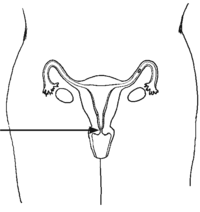Hesperian Health Guides
Common Cancers

Each type of cancer is different, with different causes, signs, and options for treatment. Some cancers are easy to prevent and treat, and some are deadly. Even in places where people live in poverty, many types of cancer can and should be treated.
Contents
Lung cancer
Signs
- Cough
- Coughing blood
- Chest pain, usually on one side
- Difficulty getting enough breath
Once someone has these signs, lung cancer is usually very advanced.
Lung cancer is the most common cancer, and it is also one of the most preventable. Its cause is usually smoking, and no matter how long you have smoked, quitting smoking at any time decreases your chances of getting lung cancer. Cigarette smoking also causes other cancers. A person living in a home with someone who smokes or who works where people smoke will also be harmed, even if she doesn’t smoke herself.

Other types of smoke also lead to lung cancer. For example, diesel exhaust from trucks, factory smoke, and smoke from cooking fires. If you smoke and you are also exposed to smoke in your workplace or home, your chances of getting lung cancer are higher.
Lung cancer is usually deadly. The best way to prevent lung cancer is to quit smoking. For help, see Drugs, Alcohol, and Tobacco (in development).
Colon and rectal cancers

With these 2 cancers of the lower digestive system, also called the bowel, you are more likely to get them if other close family members have them. They are also more common in people who already have another kind of bowel disease, such as sores inside the bowel (ulcerative colitis). Some clinics screen for these cancers by taking a sample of a person’s stool and testing it for traces of blood (with a fecal occult blood test or fecal immunochemical test--FIT).
These cancers happen less in men and women who eat vegetables, fresh fruit, whole grains, and other foods with fiber every day. Drinking less alcohol and not smoking also protect against these cancers.
Signs
- Black or bloody stool
- Belly (abdominal) pain
- A change in how you normally pass stool: increasing or decreasing frequency, or more diarrhea or constipation
Anemia can also be a sign. A feeling of weakness, and weight loss are signs if the cancer is more advanced.
Treatment
Depending on where and how much of the bowel is removed, the surgery may also include a temporary or permanent colostomy. In a colostomy, the surgeon stitches an opening in a healthy part of the intestine to an opening in the abdomen so stool can bypass the part where the cancer was removed and go directly into a container, usually a bag outside the body. As treatment and surgery techniques for colon and rectal cancers improve, fewer colostomies are needed.
Cervical cancer
When cancer affects the main part of the womb (uterus), it is called uterine cancer. When cancer affects the opening of the womb, it is called cervical cancer. Cervical cancer is a very common, slow-growing cancer that is very treatable if found early. And with good health care programs, it could be prevented altogether.
HPV, a common virus passed through sexual contact (see Sexually Transmitted Infections), is the main cause of cervical cancer. HPV is so common that most men and women get it eventually. Only some types of HPV lead to cancer.

A vaccine against HPV prevents most of the cancer-causing types of this virus (there are many types). A vaccination program for all girls and boys in your community can greatly reduce the number of women who will get cervical cancer, but it will not eliminate this cancer altogether. Screening so it can be found and treated early is most important. Both screening and treatment for cervical cancer are easy to do and very successful.
Cervical cancer is common in women who have HIV because their immune systems cannot fight infections well. It is very important for women with HIV to get tested for cervical cancer regularly — once a year, if possible.
Signs
At first, cervical cancer has no noticeable signs. Later, there can be bleeding from the vagina during sex, or any time outside of menstrual bleeding. If the cancer is not treated, it may cause pain — first in the lower back or pelvis, and later down the backs of the legs.
Testing
Cervical cancer is rarely deadly when it is found early. Screening programs that regularly test all women are easy to set up, even at very small community clinics. Each of the 3 different tests for cervical cancer has its benefits:

- Visual inspection or vinegar test, (looking at the cervix after painting it with vinegar or Lugol’s iodine). This is very low cost, does not require a laboratory, and is easy to learn how to do. Sometimes healthy cells appear to be abnormal, so if that happens other tests are used to make sure of the result. To learn how to do visual inspection, see A Book for Midwives, available from Hesperian.
- The Papanicolaou test, or Pap smear. Pap tests are very reliable but might not detect every case. Therefore they should be repeated every 3 years or so.
- The HPV test. This tests for the HPV virus that leads to cervical cancer. It may be given by itself, done along with the Pap test, or after a Pap shows there could be cancer.
Treatment
Cervical cancers caught early are among the most successfully treated. Some treatments are so easy and inexpensive they can be done in a clinic by a trained health worker, right after the examination that detected cancer.
- Cryotherapy freezes part of the cervix using carbon dioxide or nitrous oxide gas. Freezing destroys abnormal cells and prevents them from developing into cancer. Cryotherapy is not painful and is very safe. Cryotherapy is low cost and is easy for health workers and midwives to learn how to do. See A Book for Midwives, available from Hesperian.
- Loop electrosurgical excision procedure (LEEP) uses a metal loop with electricity running through it to remove the area of the cervix that has abnormal cells. LEEP is needed if the area of abnormal cells on the cervix is large, or extends inside the opening of the cervix.
- Cold knife conization uses a surgical knife to remove a larger part of the cervix if the area of the pre-cancer is very large. It is done by a specialist. Cold knife conization may make it more likely for a woman to have a miscarriage or other complications during future pregnancies.
If the cancer is advanced, it might be necessary to remove the uterus through surgery (hysterectomy). This makes pregnancy impossible, but it makes surviving the cancer very likely.
Bladder cancer
There are 3 common causes of bladder cancer:
- Smoking.
- Exposure to toxic chemicals, usually at industrial work (in factories and mines). For example, bladder cancer is more common in workers who manufacture or work with metals, paints, rubber, leather, fabric, carpets, cement, and plastics. It is also more common in miners, electrical workers, and others who work with chemicals and their fumes.
- Schistosomiasis (see Other Serious Illnesses, in development). In places where this disease is widespread, it is the most common cause.
Signs
- Blood in the urine.
- Having to pass urine very urgently or more often.
- Pain on one side of the lower back, just above the middle of the pelvic bone, or in the perineum (between the anus and the vagina or testicles).
- Urinating may be difficult, but most people with bladder cancer have no pain when they urinate.
These are all common signs of other bladder problems too. See Difficulties with Urinating (in development).
Treatment
Bladder cancer is usually treated with surgery to remove a tumor or the part of the bladder that has cancer. Chemotherapy may also be used to shrink the tumor before surgery, or to prevent the cancer from returning after surgery. If the tumor is very large, the entire bladder may need to be removed by surgery.
Bladder cancer can come back. Regular follow-up tests are needed after treatment to make sure the cancer has not returned.
Liver cancer
Liver cancer is particularly serious and is difficult to treat. It is most common in men.

Signs
There are usually no signs. However, almost everyone with liver cancer has had hepatitis or cirrhosis (liver scarring from alcoholism or disease), so the person with liver cancer may have signs of liver disease:
- Jaundice (yellow color to the skin or eyes)
- Pain in the upper right abdomen
- Swelling belly
- Feeling tired all the time (fatigue)
Prevention
This cancer is difficult to treat, but the hepatitis B vaccine helps prevent many cases. See information about hepatitis.
To prevent cirrhosis caused by alcohol, avoid drinking more than a glass or two of alcohol a day. If you already have liver disease, such as hepatitis, you can make liver cancer less likely by never drinking alcohol.
Breast cancer
Breast cancer is one of the most common cancers in women though men can have breast cancer too. When found early, breast cancer can be treated very effectively. Treatment may include surgery, radiation, chemotherapy, hormone therapy, or some combination of those.
Any person can learn to examine the breasts for any lumps or unusual signs. Cancerous lumps are usually hard, painless, jagged in shape, and unmoving under the skin. Check each breast separately. Further testing by x-ray (called mammography) or ultrasound can determine if a lump is likely to be cancer, but you will need a biopsy to be sure.
 |
A thorough breast exam takes several minutes. The woman or her health worker systematically and firmly massages each point before moving to a new point. Feel for anything unusual such as a lump, thickening, or color change. Do this for the whole breast and under the arm. |
There is not much to do to prevent breast cancer, although eating well, avoiding smoking and alcohol, and getting regular exercise helps. Breastfeeding also gives some protection.
Stomach cancer

Signs
- Belly pain
- Weight loss
- Difficulty swallowing
- A mass you can feel in the belly
- Black stool (can look like tar)
A common cause of stomach cancer is infection with H. pylori, the bacteria that causes most ulcers. While H. pylori increases the risk of stomach cancer, other things also make stomach cancer more likely, such as cigarette smoking, eating a lot of processed meats, red meats, fried food, and foods preserved in salt.
Most stomach cancers are difficult to treat successfully. It is much better to prevent this cancer. Eating fruits, raw vegetables, and whole grains every day gives some protection.
Prostate cancer
Men have a prostate gland, located just below the bladder, that grows larger as they age. Prostate cancer usually grows slowly and can take years to grow enough to cause any problems. As with other cancers, treatment for prostate cancer works best when the cancer is found early. Even prostate cancer that has spread can be treated successfully. Prostate cancer is common in men older than 65, and many older men who have prostate cancer live with it until they die, usually from other causes.
Signs
Prostate cancer may have no signs in its early stages. Most men don’t know they have it until it is found during a medical exam.
The most common sign is problems with urinating, but this can also be caused by a non-cancerous enlarged prostate, common in older men.
Reasons to see a health worker:
- Difficulty starting or stopping the flow of urine
- Needing to urinate often, especially at night
- Pain or burning during urination
- Blood in your urine or semen
- Deep and frequent pain in your lower back, belly, hip, or pelvis
A blood test called the prostate-specific antigen (PSA) can help detect prostate cancer. A high PSA may mean prostate cancer, but it could also mean that you have an enlarged or infected prostate (see Difficulties with Urination, in development).
Treatment
How prostate cancer is treated (surgery, radiation, chemotherapy, hormone therapy, or a combination of these) will depend on the kind of cancer cells, if they have spread, your age and general health, and your preferences. Some prostate cancer grows so slowly that the only treatment is to have regular check-ups.
Skin cancer
Skin cancers are common among light-skinned people, and rare among dark-skinned people, but can happen to anyone. They happen most often to adults who had severe sunburns when they were children.
There are 2 main types. Non-melanoma skin cancer, the most common type, is easily treated because it grows slowly and can be cut out by a health worker. The other main type, called melanoma, is the most dangerous kind of skin cancer.

A non-melanoma cancer often looks like a slowly growing red or pink bump, sore, or scab on the face or elsewhere on the skin. These should generally be cut out if they continue to grow because they can spread cancer inside the body.
Melanoma is a skin cancer that is fast growing and dangerous and should be treated right away. First the affected area is cut out. Other treatment may be needed if the cancer has spread to other parts of the body.
Signs of melanoma skin cancer
A melanoma looks different than a mole in one or more of these ways:
| Has an uneven, unusual shape that isn’t a circle or an oval | |
 |
Has jagged or uneven edges |
 |
Has different colors in the same mole |
| Changes in size, color, or shape |

Prevention
Protect children, especially fair-skinned children, with hats, clothes that cover arms and legs, and sunscreen lotion.
If you work outdoors, cover your skin and wear a hat.
Kaposi’s sarcoma
A skin cancer that affects some people infected with HIV, Kaposi’s sarcoma shows as red, brown, or purple-colored patches inside the mouth or anywhere on the body.
Signs
Painless patches that look like swollen bruises around or inside the mouth, or anywhere else on the body. The patches rarely become infected or painful, unless they open.
Treatment
See a health worker or doctor who is experienced with HIV. Antiretroviral medicines (ARVs) tend to prevent this cancer in people with HIV, and starting ARV treatment can keep it from getting worse. Sometimes Kaposi’s sarcoma is treated with chemotherapy or with other medicines.


